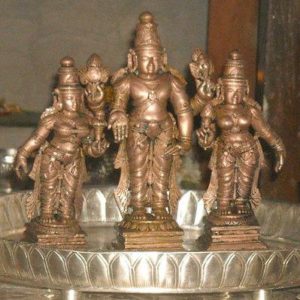Situated about 35 km from Mangalore is the quaint town of Moodbidri as it is now called or Mudabidure or Biderayanagara or Venupura or Vamsapura as it has been called at various points in history. All these names are linked to the wild bamboo (Bidure) growth in the area and the Venu (flute) made out of them. But all that is history now! Today, you will hardly find any bamboo growth in the region except for a place called ‘Soans Farm‘ established by the Soans group that runs a couple of other eco-tourism spots along the coast of Karnataka.
A Google Search on ‘Moodabidri’, will bring up a lot of articles around it being the Jain Kashi with its most popular 1000 pillared Jain temple which is a legend in itself. However, there are very very few articles on the three GSB temples that are core to the town – the Venkatramana temple, the Mahalasa temple, and the Karnik Hanuman Temple. The Venkataramana and Hanuman temples are strongly associated with each other.
It is a tradition that before commencing any auspicious occasion, a prayer is offered to the deity to request his/her blessing that all the festivities are carried on without any vighn (interruptions). In Moodabidri, before commencing any festivities at the SVLT temple, a prayer is offered not just to Lord Venkataramana but also Lord Hanuman. Similarly, any such offering for festivities at the Hanuman temple is also offered at the Venkataramana temple. The visit to one is incomplete without a visit to the other. Lord Hanuman is the Mukhyaprana while Lord Venkataramana his Lord (Odeya) is the Sarvaprana.
The Venkatramana temple here in Moodbidri is supposed to have rog-nivarak (remedy of maladies) shakti. The inner garbhagudi currently has the following deities:
- The original Shri Lakshmi Venkatesha idol that belonged to the original priest family from the Vashisht Gotra
- The 'panchloha' Lord Venkataramana idol with Sridevi and Bhoodevi created by famous shilpi Shri Renjala Gopala Shenoy, installed in 1933 by Shri Sukruteendra Tirth Swami of Kashi Mutt
- Garuda and Hanuman also installed in 1933
- Lord Gopalkrishna with Rukmini and Satyabhama as the Utsav Murti that is taken out during temple festivals and processions.
- Shaligrama
- A 'panchloha' panchmukhi Hanuman
- Parivar Devatas - stone idols of Mahaganapati and Mahalakshmi installed in 1960 by Shri Sudhindra Tirth Swami of Kashi Mutt. This is in addition to the original 'panchloha' idols of these deities.
There is an Ashwatha tree in front of the temple entrance. Also, the Nagabrahma and Nagalaya are installed opposite the temple entrance.
In terms of history, the exact origins of the Venkataramana Temple are unknown. The earliest record found is from the year 1818 in a legal document where the temple idols and rituals were elaborated and the management was handed over to the temple committee. The title used for the temple in this document is Hoskeri Sri Lakshmi Venkatesh temple. But there are no reliable traces regarding the name Hoskeri associated with the temple. But it is certain that before 1818, this temple was a small garbagudi sheltering the 'Shri Lakshmi Venkatesha' idol.
To quote from the book the Saraswat Heritage "There are not many authentic records available about the antiquity and development of this temple. As per the available records, the temple complex gutted in the fire mishap in the mid-thirteenth decade. A person called Nagara Damarsa Pai in the 12th century established twelve temples with the supernatural powers he conjured up through the Parashu stone. It is said this temple is one of the twelve shrines established by him. "
The temple does not have a rathothsava(chariot festival) unlike some of the other SVLT temples. The most important celebration here is on Kartik Pournima (Kartik Punav). The day before Kartik Pournima, a vanbhojan (forest lunch ) is arranged near the local lake for the temple Gopalkrishna and the Gopalkrishna from the Mahamamya temple.
For a darshan of the temple check out the following videos by Spandana Channel and Youth of GSB.
